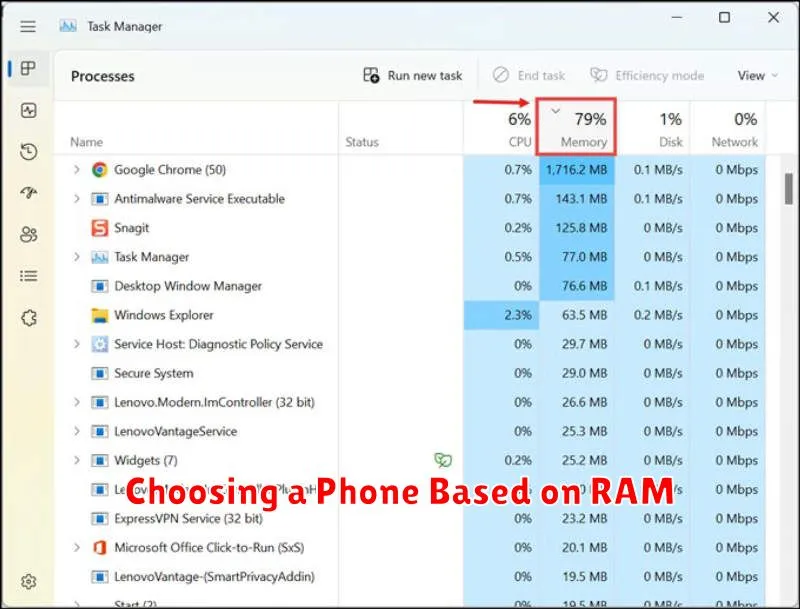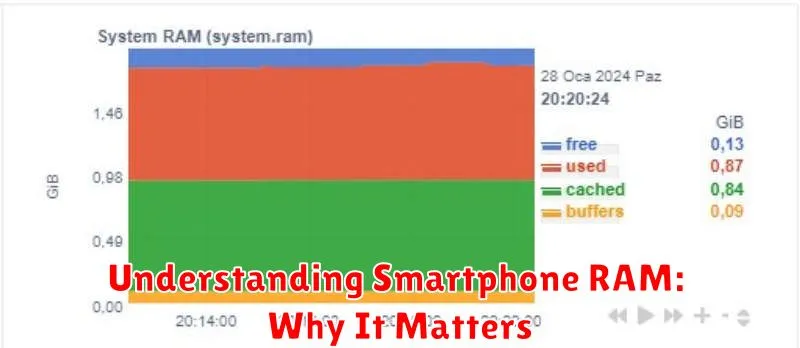In today’s fast-paced digital world, smartphones have become indispensable tools. We rely on them for everything from communication and entertainment to productivity and navigation. But have you ever stopped to consider what makes your smartphone tick? One crucial component that significantly impacts performance is RAM, or Random Access Memory. Understanding smartphone RAM is essential for making informed decisions when purchasing a new device and for optimizing the performance of your current one. This article will delve into the intricacies of smartphone RAM, explaining what it is, why it matters, and how it affects your overall user experience.
Smartphone RAM is essentially the short-term memory of your device. It’s where the operating system (OS), apps, and data currently in use are stored for quick access. The more RAM your smartphone has, the more information it can hold readily available, allowing for smoother multitasking, faster app loading times, and a more responsive overall experience. Insufficient RAM, on the other hand, can lead to frustrating slowdowns, app crashes, and a generally sluggish performance. This guide will explore the nuances of smartphone RAM and its impact on various aspects of your mobile experience, helping you understand why it’s such a critical factor to consider.
What Is RAM in a Smartphone?
RAM, or Random Access Memory, is your smartphone’s short-term memory. It’s a crucial component that determines how efficiently your phone can multitask and run applications. Think of it as a workspace where your phone loads apps and data for quick access.
Unlike storage, which holds data permanently (like apps, photos, and videos), RAM only holds information temporarily. When you close an app, the data associated with it is cleared from RAM. This is why having sufficient RAM is essential for smooth performance. More RAM allows your phone to keep more apps and processes readily available, leading to faster switching between tasks and reduced lag.
How RAM Affects Performance
RAM, or Random Access Memory, is essential for smartphone performance. It acts as the device’s short-term memory, storing actively used data for quick access by the processor. More RAM allows more applications and processes to run simultaneously without slowing down the phone.
With insufficient RAM, the system starts using slower storage, like the internal drive, as virtual memory. This process, known as “swapping” or “paging,” drastically reduces performance, leading to noticeable lag and stuttering.
Adequate RAM ensures smooth multitasking, quicker app loading times, and a more responsive user experience overall. The amount of RAM needed depends on individual usage; heavy users who frequently multitask or play demanding games will benefit more from higher RAM capacities.
RAM and Multitasking Capabilities

RAM, or Random Access Memory, plays a crucial role in a smartphone’s multitasking performance. It serves as the device’s short-term memory, holding currently active apps and data. The more RAM a phone has, the more apps and processes it can manage simultaneously without slowing down.
With insufficient RAM, the phone’s operating system will begin closing background apps to free up resources. This leads to a less fluid experience when switching between different applications. Larger RAM capacities allow for seamless transitions between multiple apps, enabling users to quickly jump from browsing the web to checking email, editing photos, and more, without experiencing performance hiccups.
Optimal RAM for Different Users
The ideal amount of RAM in a smartphone isn’t one-size-fits-all. It depends heavily on user behavior and needs. Light users, primarily focused on basic tasks like calling, texting, and occasional web browsing, can comfortably manage with 4GB of RAM.
Moderate users who engage in more demanding activities such as social media, streaming video, and light gaming, should consider 6GB to 8GB of RAM for a smooth experience. This range offers a good balance between performance and cost-effectiveness.
Power users, including mobile gamers, content creators, and those who frequently multitask with numerous apps, will benefit significantly from 8GB or more. This ensures seamless performance even with resource-intensive applications and heavy multitasking.
RAM vs Storage: Know the Difference
While both RAM and storage hold data, they serve distinct purposes and have different characteristics. RAM (Random Access Memory) is your phone’s short-term memory. It holds data that is actively being used by apps and the operating system. When you close an app, the data in RAM is cleared. RAM is volatile, meaning it requires power to retain data.
Storage, on the other hand, is your phone’s long-term memory. It stores files, apps, photos, videos, and the operating system itself. Data in storage remains even when your phone is powered off. Storage is non-volatile.
Think of it this way: RAM is like your desk where you work on current projects, while storage is like a filing cabinet where you keep all your documents.
Android vs iOS RAM Efficiency
A key difference between Android and iOS lies in their RAM management strategies. iOS is renowned for its efficiency, often requiring less RAM to perform similarly to Android. This efficiency stems from iOS’s tight integration of hardware and software, allowing for optimized memory allocation and reclamation.
Android, being more open and supporting a wider range of hardware, employs a different approach. Its RAM management is more flexible, allowing apps to reside in memory longer for quicker access. While this can lead to smoother multitasking in some scenarios, it can also result in higher overall RAM consumption.
RAM Management Features
Modern smartphones incorporate sophisticated RAM management features to optimize performance and battery life. These features work behind the scenes to ensure that the available RAM is used efficiently.
One key feature is app prioritization. The system identifies frequently used apps and keeps them readily available in RAM, allowing for faster loading times. Less frequently used apps are moved to secondary storage to free up RAM.
Another important aspect is garbage collection. This process identifies and removes unused data from RAM, freeing up space for active applications. Efficient garbage collection minimizes performance hiccups and improves overall system responsiveness.
Future RAM Trends in Phones
The future of RAM in smartphones is focused on increased capacity, improved speed, and enhanced efficiency. We can expect to see higher RAM capacities becoming more commonplace, exceeding current standards. This will allow for even more demanding applications and seamless multitasking.
Faster RAM speeds are also on the horizon, leveraging new technologies like LPDDR6 and beyond. This will lead to improved performance and responsiveness across the entire device.
Furthermore, advancements in RAM management and integration with other components will contribute to better power efficiency, extending battery life even with increasing processing demands.
How to Check RAM Usage
Checking your smartphone’s RAM usage is crucial for understanding its performance. The method varies depending on the operating system.
Android
On most Android devices, you can check RAM usage through the Settings app. Typically, you’ll find this information under a section named “Memory,” “Apps & notifications,” or “Developer options” (which may need to be enabled first). Look for options like “Memory usage,” “Running services,” or “RAM usage.” This section will usually show the total RAM, used RAM, and available RAM.
iOS (iPhone/iPad)
iOS doesn’t offer a built-in way to directly check RAM usage like Android. While some third-party apps claim to show this information, their accuracy isn’t guaranteed. Instead, focus on observing your device’s performance. Sluggishness or frequent app crashes can indicate high RAM usage.
Choosing a Phone Based on RAM

The amount of RAM you need depends heavily on your smartphone usage. For basic tasks like calling, texting, and browsing, 4GB of RAM is generally sufficient.
Moderate users who engage in social media, light gaming, and multitasking may find 6GB or 8GB of RAM a more comfortable experience. This prevents apps from closing in the background and ensures smoother performance.
Power users who play demanding games, use resource-intensive apps, or frequently multitask should opt for higher RAM options, such as 12GB or even 16GB, for optimal performance and to avoid lag.

